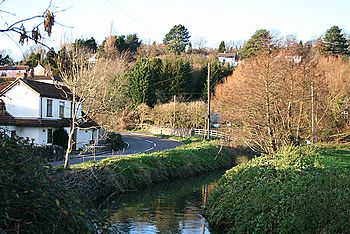Land Yeo facts for kids
Quick facts for kids Land Yeo |
|
|---|---|

The Land Yeo by Jacklands Bridge, Nailsea
|
|
| Country | England |
| County | Somerset |
| Cities | Barrow Gurney, Nailsea, Wraxall, Somerset, Tickenham, Clevedon |
| Physical characteristics | |
| Main source | Dundry Hill, Somerset, England 51°23′56″N 2°39′06″W / 51.39889°N 2.65167°W |
| River mouth | Bristol Channel Clevedon, Somerset, England 0 ft (0 m) 51°25′42″N 2°52′33″W / 51.42833°N 2.87583°W |
The Land Yeo is a small river in North Somerset, England. It starts on Dundry Hill and flows through several villages. Eventually, it reaches Clevedon and empties into the Bristol Channel.
For over 1,000 years, this river powered many watermills. Today, only one of these old mills still works. Since 2003, people have been working to clean up the river. These efforts have made the water cleaner and helped local wildlife thrive.
Journey of the Land Yeo
The Land Yeo begins its journey from small springs. These springs are found on the western side of Dundry Hill. The river then flows into the Barrow Gurney Reservoirs. These reservoirs hold drinking water for the city of Bristol.
Next, the river passes through the village of Barrow Gurney. Here, you can see it in old millponds. It then goes north, flowing under the A370 road and the Bristol to Exeter railway line. This area is close to an ancient Roman settlement called Gatcombe.
The Land Yeo continues west past the Tyntesfield Estate. It flows north of Nailsea, where Jacklands Bridge crosses over it. The river also passes south of Wraxall. It then moves through a man-made channel near Tickenham. This part of the river forms the northern edge of the Tickenham, Nailsea and Kenn Moors SSSI, which is a special wildlife area.
Finally, the river flows under the M5 motorway. It goes through Clevedon, where it joins another small river called the Middle Yeo. Together, they flow into the Bristol Channel.
Historic Watermills
For hundreds of years, the Land Yeo was a very important river. It provided power for many watermills. Some of these mills were built as far back as the time of the Domesday Book. These mills were used for different jobs.
Many mills ground corn to make flour. Others were used as gristmills, which grind grain. Some mills were even changed to make snuff, a type of tobacco.
- Barrow Gurney Mills: There were three mills in Barrow Gurney. The Upper Barrow Mill ground corn and stopped working by 1935. The Middle Mill was used to make snuff around 1800. The Lower Mill also ground corn. It was rebuilt in 1909 and still makes animal feed today. However, its waterwheel is no longer used.
- Gatcombe Mill: Near the Roman site at Gatcombe, there was another mill. It was first used for snuff in 1769. Later, it ground mustard and other things, then became a flour mill. The old machinery is still inside, and it is a protected historic building.
- Kincott Mill: This mill has been around since the 1200s. In the 1800s, it was used for snuff and later for flour. It was also owned by a metalworker who made farm tools.
- Bourton Mill: North of Flax Bourton, there are remains of Bourton Mill. It might have existed during the Domesday Book era. The river was even moved to flow through its old channel. Today, only a small part of the mill building is left.
- Wraxall Mills: At Watercress Farm in Wraxall, there is a waterwheel that still works. It was built before 1885 and pumps water. Another mill in Wraxall stopped working by 1885, and only crumbling walls remain.
- Tickenham Mill: The mill at Tickenham was built in the 1100s. It was later used as a water pump. Now, it has been turned into a private house.
- Clevedon Mills: Clevedon had at least two mills. The Tuck Mills were used for fulling cloth, which means cleaning and thickening it. Other mills near Wain's Hill likely started in the early 1600s.
River Cleanup and Wildlife
In 2003, a group called the Friends of the Land Yeo was formed. Their goal is to look after the river and make it better. They work to remove trash and keep the river clean.
Because of their hard work, the water quality has greatly improved. This means more fish now live in the river. The cleaner water has also made the river a better home for many birds and mammals. You might spot kingfishers, little egrets, herons, swans, and even otters. The group is also creating walking paths along the river.
In 2011, they received a grant of £200,000. This money helps them do even more work on the wetlands of the North Somerset Levels. Their efforts continue to help the river's plants and animals thrive.
Images for kids


